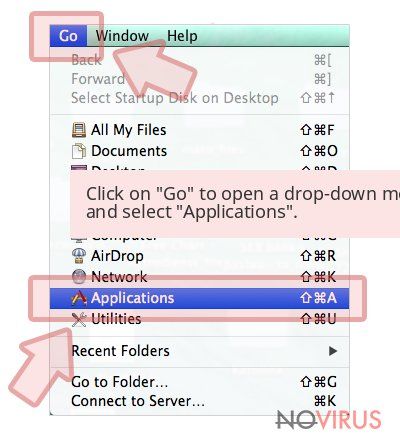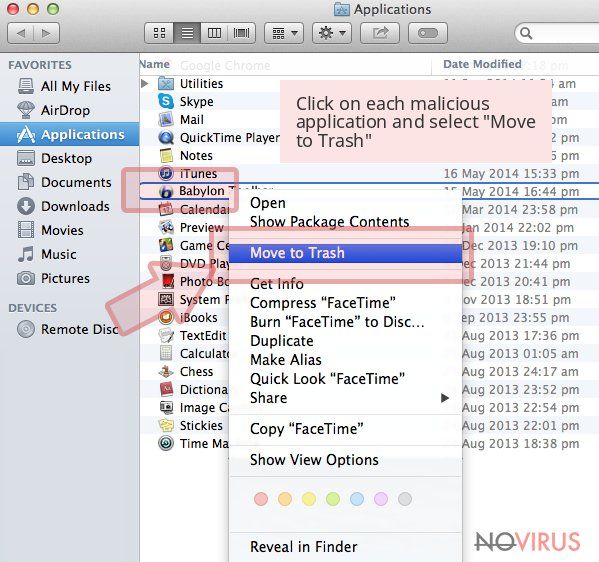Uninstall Nginx virus (Jul 2017 updated) - Free Removal Guide
Nginx virus Removal Guide
Description of Nginx Virus
Nginx virus travels in the disguise of a blank page
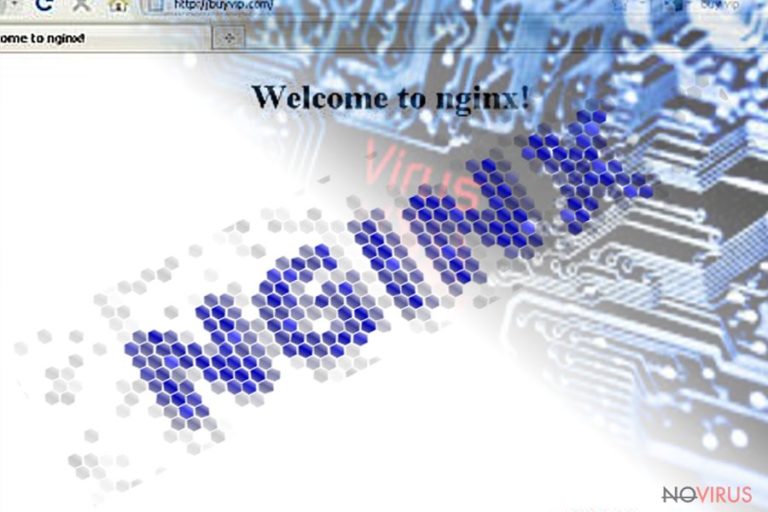
Nginx virus is defined as a browser threat, specifically, a web script, which targets all major browsers, including Chrome, Internet Explorer, Firefox, MS Edge, etc. Even if you are cautious not to visit moot web pages, there is still a high probability of encountering this infection even if you occasionally shop online. It may contain the URL referrer to one such web page.
Speaking of the very web page, the question what is the initial purpose remains rhetoric. Once you get redirected to this web page, you are greeted with ‘Welcome to Nginx!‘ Nonetheless, no visible content appears. Once you are there, you may get misguided to another questionable affiliated web page nginx.org. Naturally, the question arises what is nginx.irg?
According to the content, it seems to promote Nginx app versions. You should not mistake it with the legitimate version advertised at nginx.com.
Thus, considering its obscure behaviour, it is possible to assume that the domain serves for more malicious purposes, such as browser redirect threats. They facilitate such outcomes:
- Redirections to ad-supportive gaming web pages
- Pop-up alerts emerge in new tabs or as banners distracting during a browser session
- Changed default search engine
Even though Nginx is considered to be a browser infection, it does not normally “hijack” your browser. However, its original purpose may be more grandeur and more menacing. Leave alone the very content, the web page contains neither terms of use nor privacy policy – crucial documents for every reliable website. Therefore, this fact is another reason why you should remove Nginx virus scripts.
Disguise for what?
This technique disguising under a blank page is not new. Unfortunately, there are numerous similar domains which employ a similar disguise to cover their initial purpose. You may recall 1.loadblanks.ru as well.
Likewise, it is possible to nurture different theories what is the primary purpose of the domain. You should not exclude the probability that exploit kits may disguise under similar domains.
Furthermore, such web pages may also carry tracking elements, such as cookies, pixels, beacons, which collect certain information about your online activities. After collecting enough information, the domain transmits the data to respective third parties which then are able to create relevant pay-per-click ads.
Note that this malware is also available on Android phones and all browsers. It especially manifests a tendency to plague Firefox users. If you are already wondering how to remove Nginx from your phone, take a look at the final section of the article.
Since there is no explicit information as to what privacy policy this domain follows and what third parties it operates, you should not disregard Nginx redirect phenomenon. It is possible that you may be directed to highly fraudulent domains. 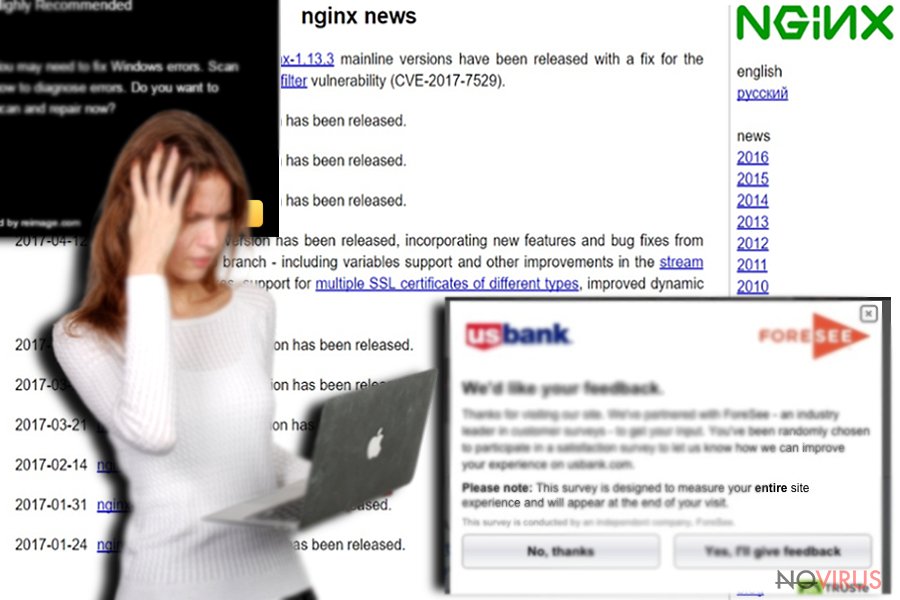
Ways to spread browser threats
Nginx malware employs insidious techniques to expand its distribution rate. Having a shapeless form, this threat functions in the form of web scripts which grants flexibility.
Therefore, you are not likely to experience Nginx hijack the usual way, i.e. downloading it with another free application. Nonetheless, in order to lower the risk of encountering this infection, scanning the system with an anti-spyware application, such as FortectIntego orMalwarebytes should be your priority. The software will also assist in battling more complex virtual threats.
Eliminate Nginx infection from your phone and computer
Regarding the fact that this malware does not have its own application, you will not have to waste time to uninstall Nginx. Nonetheless, its eradication process requires attention.
It is of utmost importance to terminate the infection on the device but especially remove Nginx from Android and other smartphones properly. In that case, tracking the root of infection might be futile.
Let an anti-malware app help you with Nginx removal, Malwarebytes has its own mobile version so you will save time on meddling with the threat. This software also helps you remove Nginx virus efficiently from the device.
You may remove virus damage with a help of FortectIntego. SpyHunter 5Combo Cleaner and Malwarebytes are recommended to detect potentially unwanted programs and viruses with all their files and registry entries that are related to them.
Getting rid of Nginx virus. Follow these steps
Uninstall Nginx in Windows systems
Terminate suspicious programs from Windows 10/8 machines by following these instructions:
- Type Control Panel into Windows search and once the result shows up hit Enter.
- Under Programs, choose Uninstall a program.
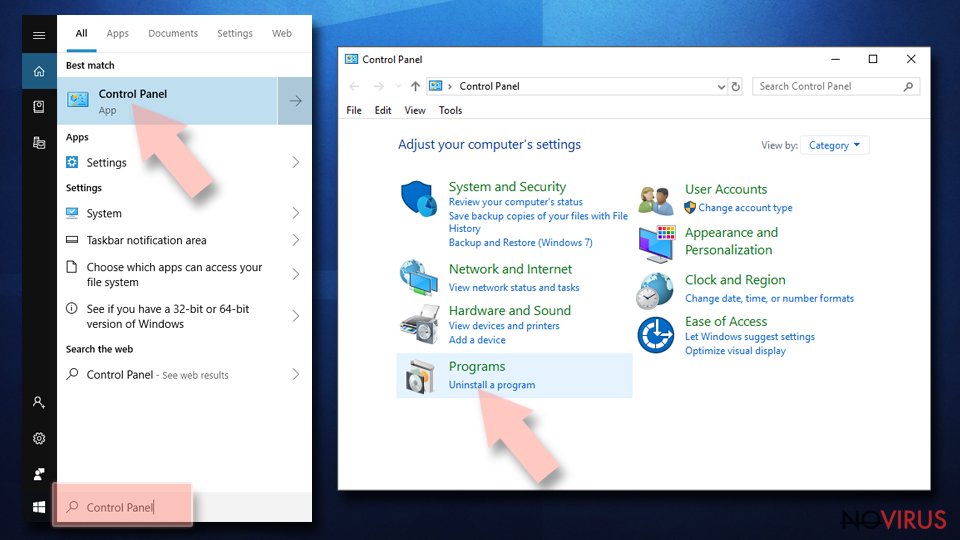
- Find components related to suspicious programs.
- Right-click on the application and select Uninstall.
- Click Yes when User Account Control shows up.
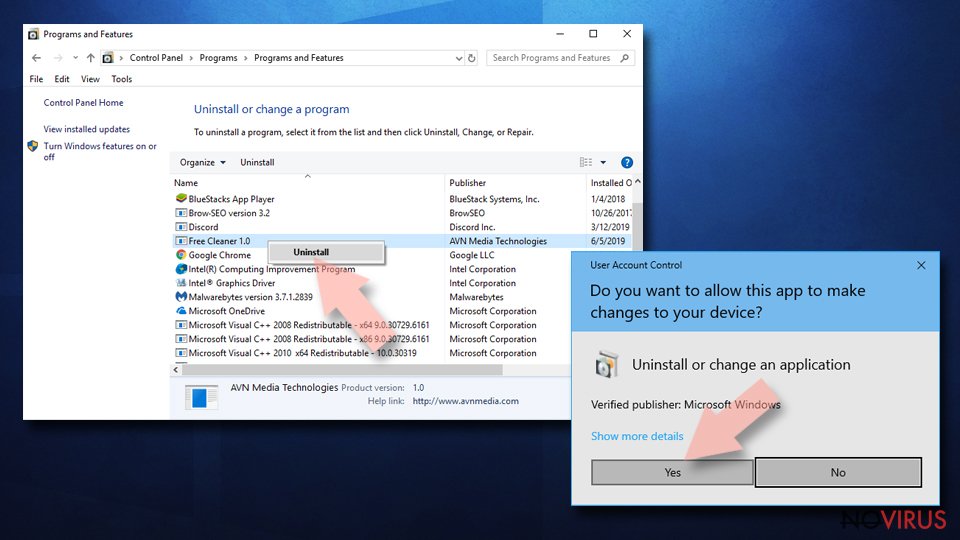
- Wait for the process of uninstallation to be done and click OK.
Windows 7/XP instructions:
- Click on Windows Start and go to Control Panel on the right pane.
- Choose Add/Remove Programs.
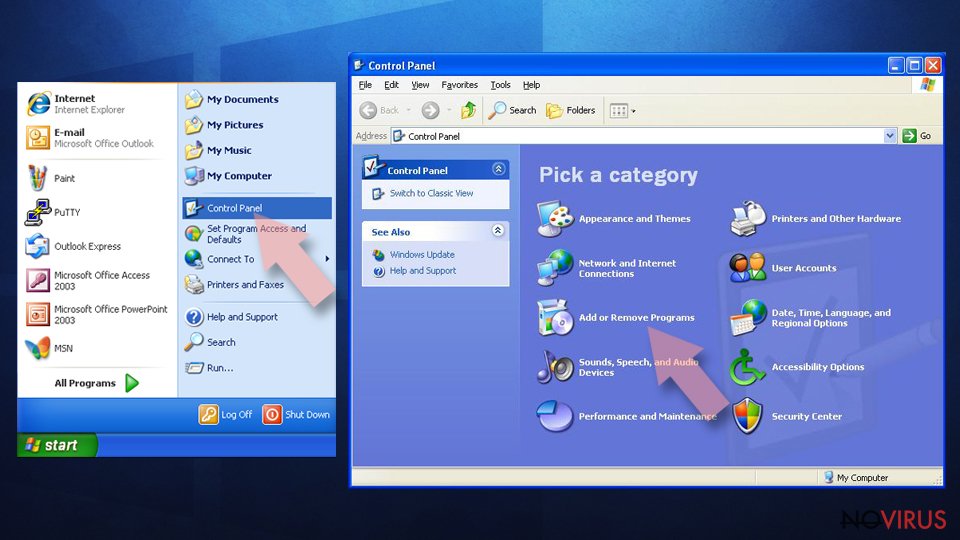
- Select Uninstall a program under Programs in Control Panel.
- Click once on the unwanted application.
- Click Uninstall/Change at the top.
- Confirm with Yes.
- Click OK and finish the removal.
Uninstall Nginx in Mac OS X system
-
Users who use OS X should click on Go button, which can be found at the top left corner of the screen and select Applications.

-
Wait until you see Applications folder and look for Nginx or any other suspicious programs on it. Now right click on every of such entries and select Move to Trash.

Eliminate Nginx virus from Microsoft Edge browser
Delete suspicious extensions from MS Edge:
- Go to the Menu by clicking on the three horizontal dots at the top-right.
- Then pick Extensions.
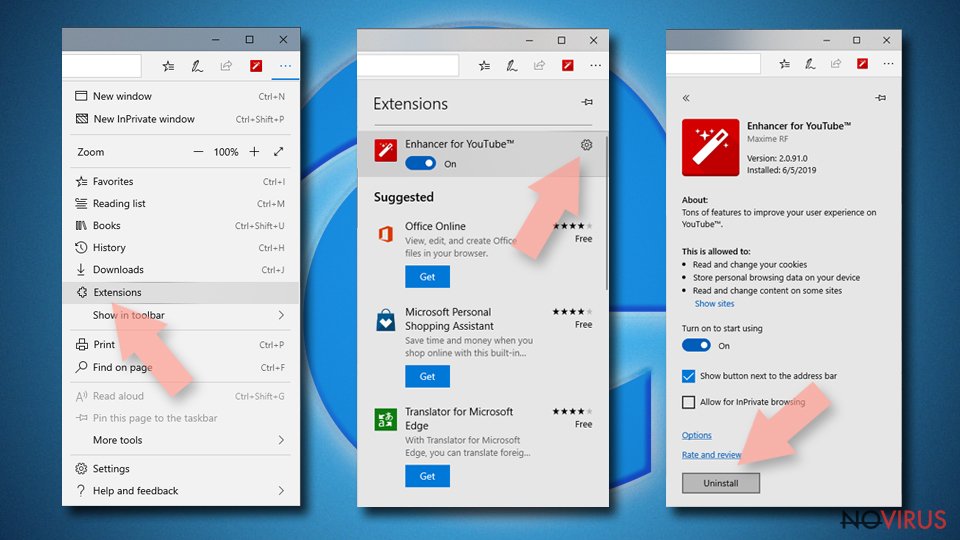
- Choose the unwanted add-ons on the list and click on the Gear icon.
- Click on Uninstall at the bottom.
Clear cookies and other data:
- Click on the Menu and from the context menu select Privacy & security.
- Under Clear browsing data, select Choose what to clear.
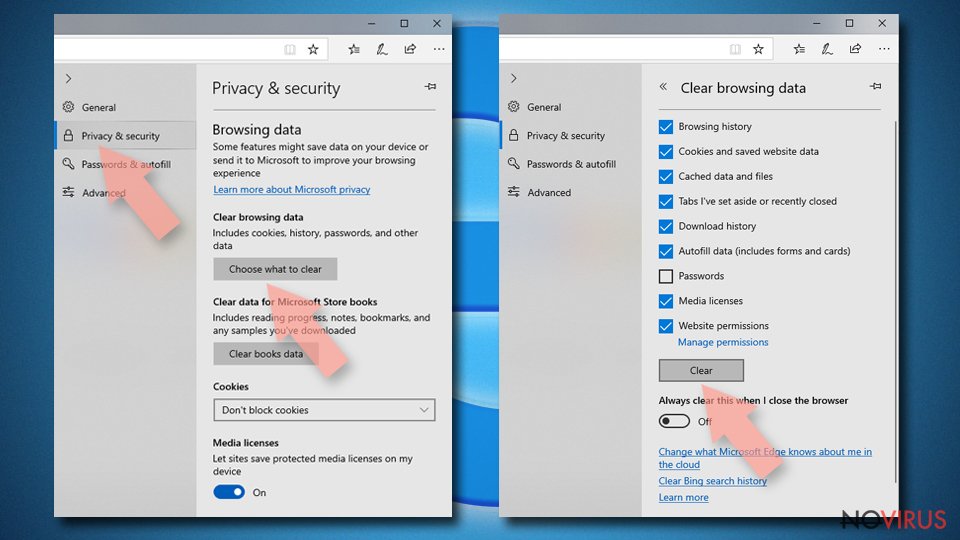
- Choose everything except passwords, and click on Clear.
Alter new tab and homepage settings:
- Click the menu icon and choose Settings.
- Then find On startup section.
- Click Disable if you found any suspicious domain.
Reset MS Edge fully:
- Click on the keyboard Ctrl + Shift + Esc to open Task Manager.
- Choose More details arrow at the bottom.
- Go to Details tab.
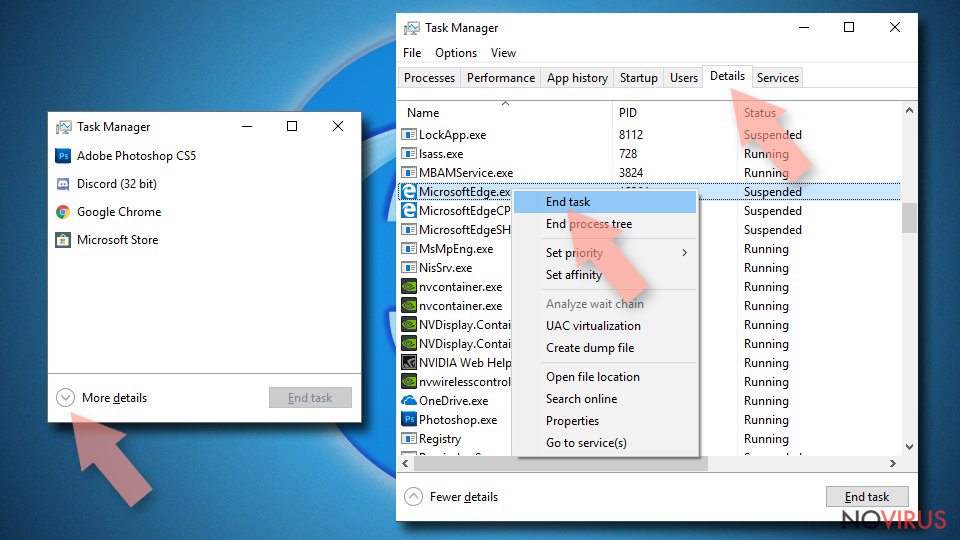
- Now scroll down and locate every entry with Microsoft Edge name in it.
- Right-click on each of them and select End Task to stop MS Edge from running.
When none of the above solves the issue, you might need an advanced Edge reset method, but you need to backup your data before proceeding.
- Find the following folder on the PC: C:\\Users\\%username%\\AppData\\Local\\Packages\\Microsoft.MicrosoftEdge_8wekyb3d8bbwe.
- Press Ctrl + A on your keyboard to select all folders.
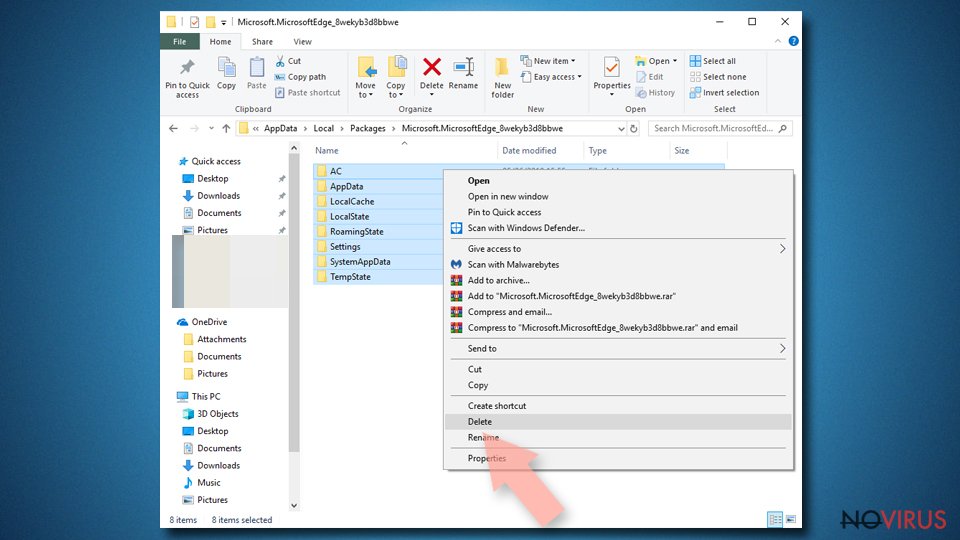
- Right-click on the selection and choose Delete
- Right-click on the Start button and pick Windows PowerShell (Admin).
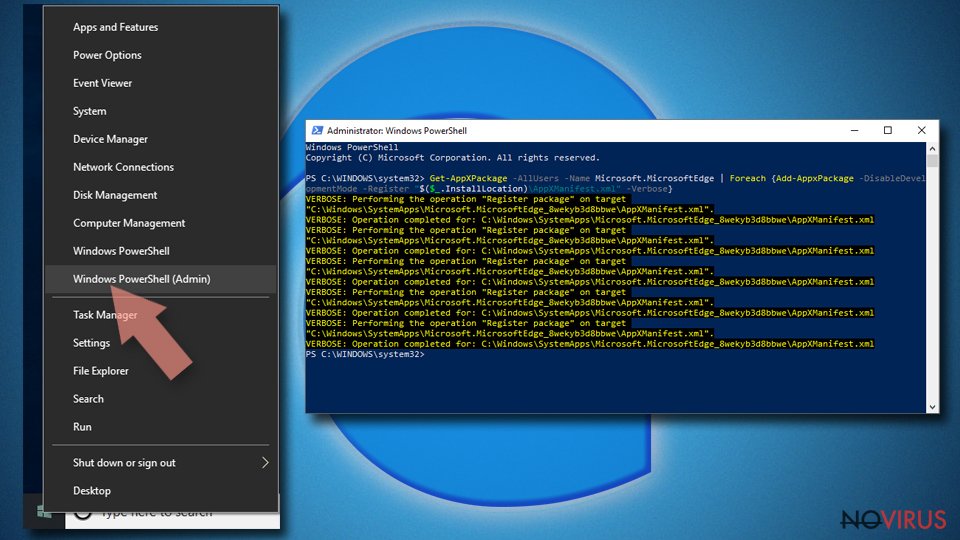
- Copy and paste the following command, and then press Enter:
Get-AppXPackage -AllUsers -Name Microsoft.MicrosoftEdge | Foreach {Add-AppxPackage -DisableDevelopmentMode -Register “$($_.InstallLocation)\\AppXManifest.xml” -Verbose
Instructions for Chromium-based Edge
Delete extensions:
- Open Edge and click Settings.
- Then find Extensions.
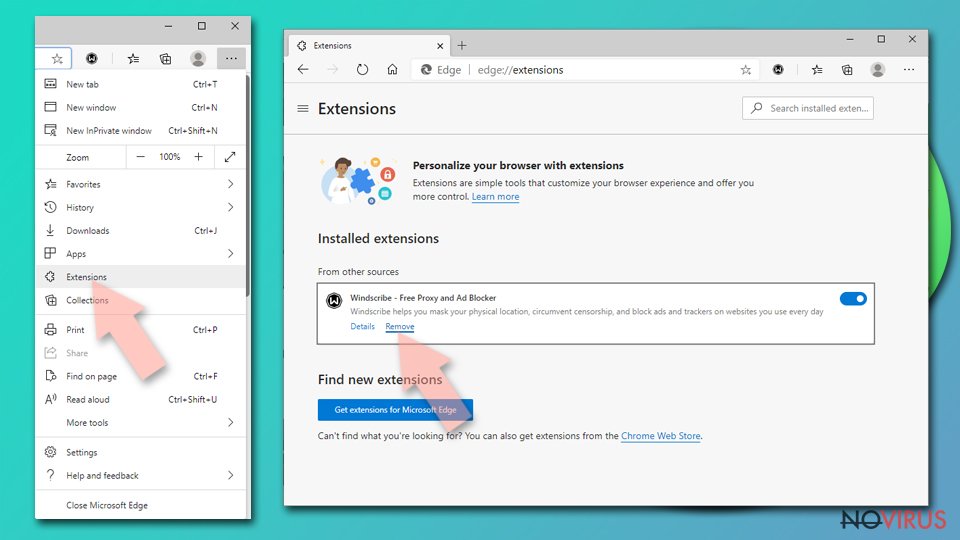
- Delete unwanted extensions with the Remove.
Clear cache and site data:
- Click on Menu and then Settings.
- Find Privacy and services.
- Locate Clear browsing data, then click Choose what to clear.
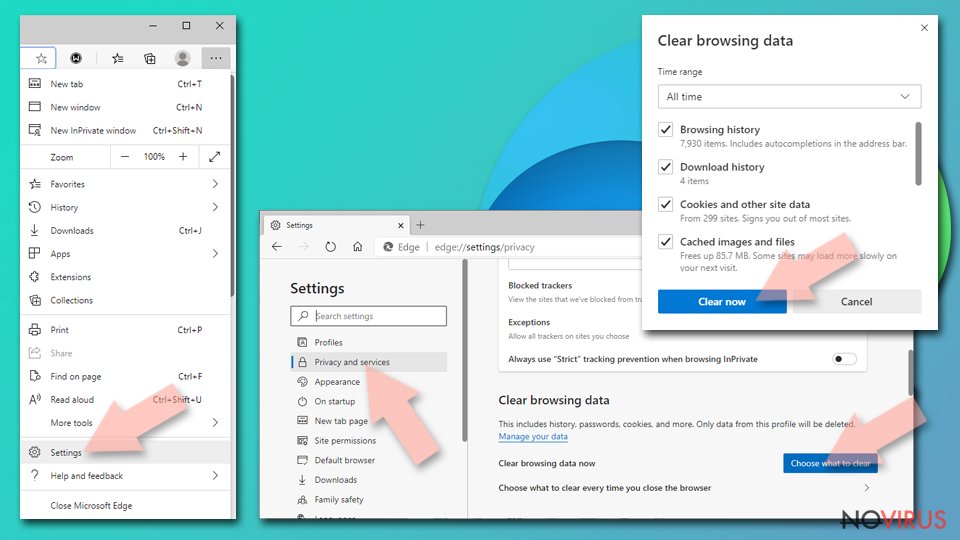
- Time range.
- Click All time.
- Select Clear now.
Reset Chromium-based MS Edge browser fully:
- Go to Settings.
- On the left side, choose Reset settings.
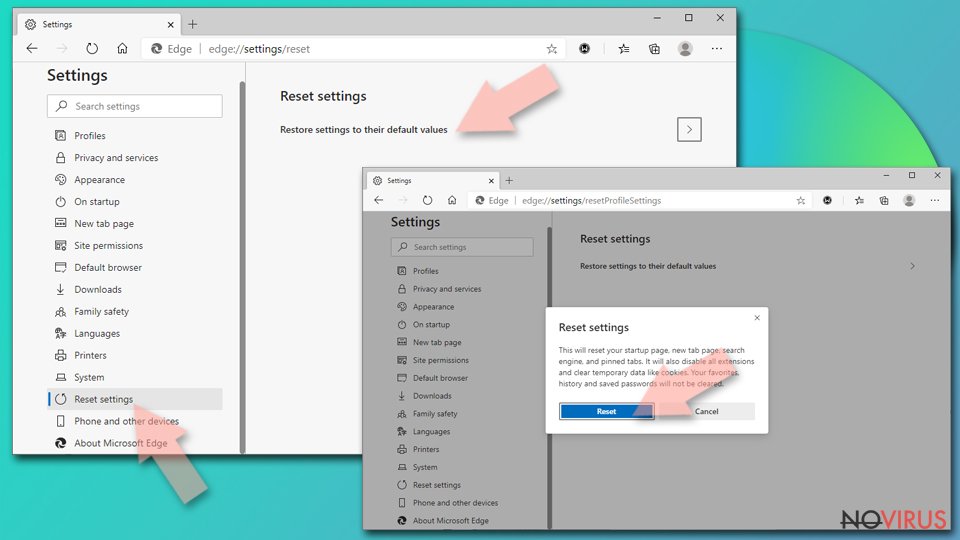
- Select Restore settings to their default values.
- Click Reset.
Delete Nginx from Mozilla Firefox (FF)
If you pay attention to every detail, you will remove Nginx from Firefox efficiently. Check whether the malware did not append any unnecessary toolbars and associated browser extensions.
[GI=google-chrome]
Remove suspicious Firefox extensions:
- Open Mozilla Firefox browser and click on the three horizontal lines at the top-right to open the menu.
- Select Add-ons in the context menu.
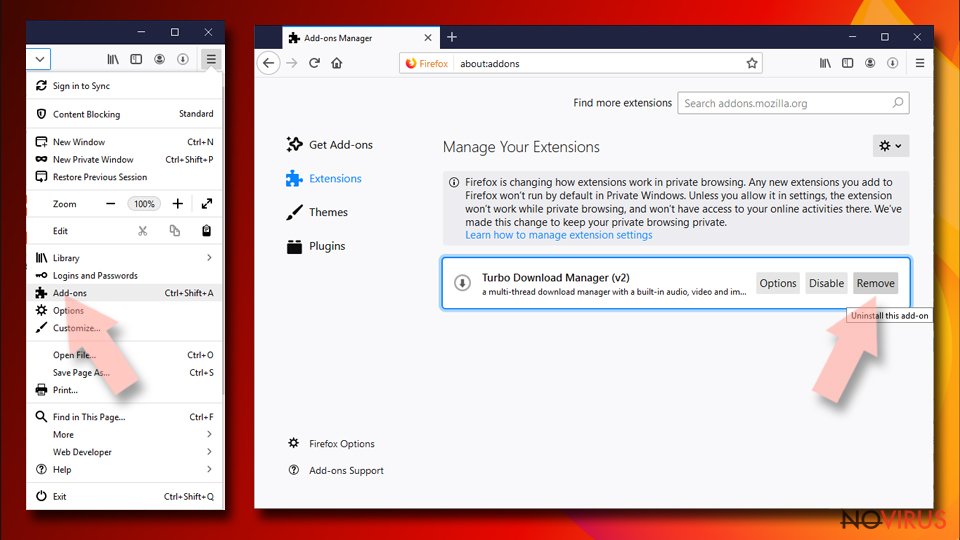
- Choose plugins that are creating issues and select Remove.
Reset the homepage on the browser:
- Click three horizontal lines at the top right corner.
- This time select Options.
- Under Home section, enter your preferred site for the homepage that will open every time you launch Mozilla Firefox.
Clear cookies and site data:
- Click Menu and pick Options.
- Find the Privacy & Security section.
- Scroll down to choose Cookies and Site Data.
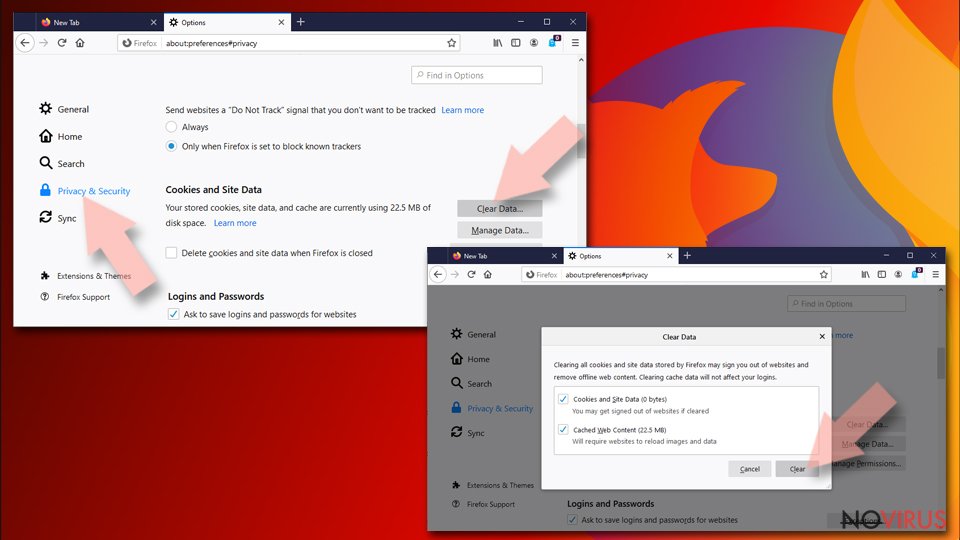
- Click on Clear Data… option.
- Click Cookies and Site Data, Cached Web Content and press Clear.
Reset Mozilla Firefox:
If none of the steps above helped you, reset Mozilla Firefox as follows:
- Open Mozilla Firefox and go to the menu.
- Click Help and then choose Troubleshooting Information.
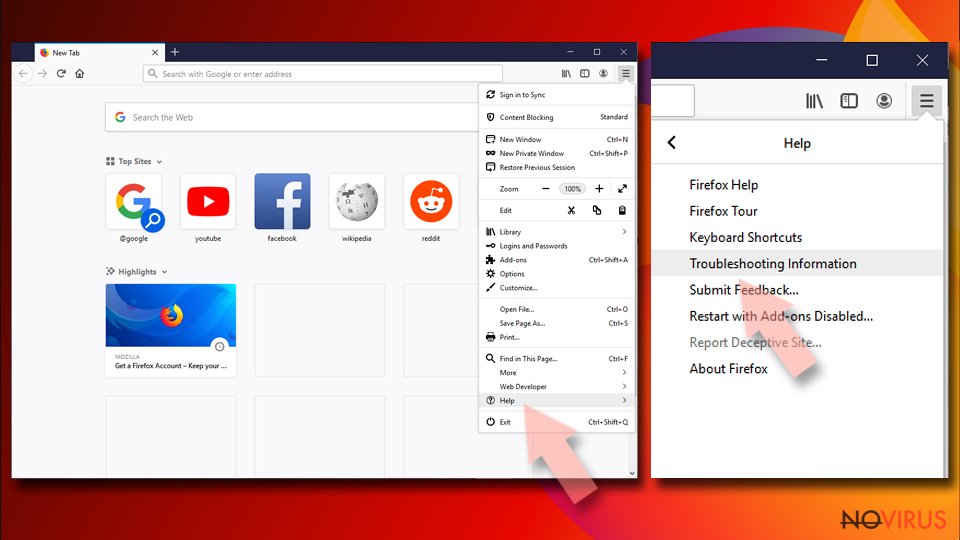
- Locate Give Firefox a tune-up section, click on Refresh Firefox…
- Confirm the action by pressing on Refresh Firefox on the pop-up.
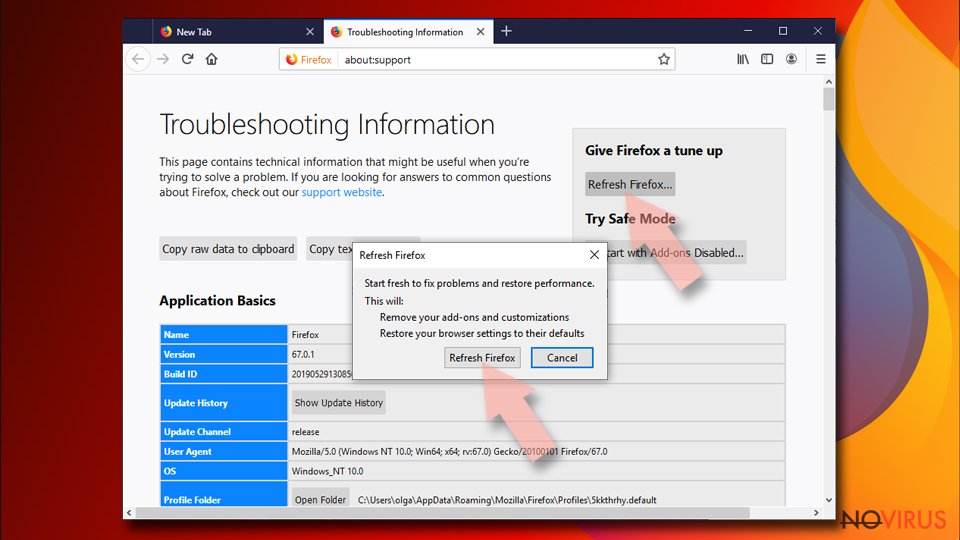
Delete Nginx from Safari
Get rid of questionable extensions from Safari:
- Click Safari.
- Then go to Preferences…
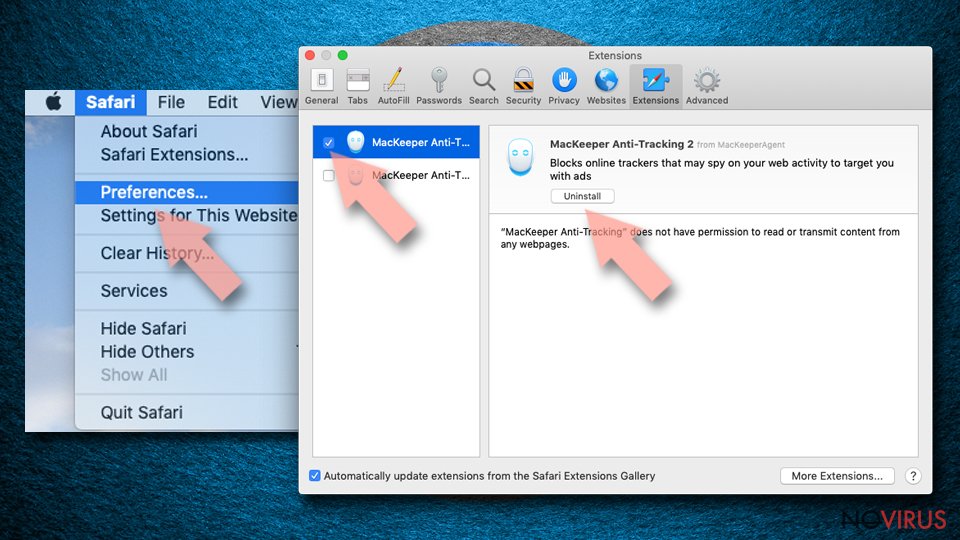
- Choose Extensions on the menu.
- Select the unwanted extension and then pick Uninstall.
Clear cookies from Safari:
- Click Safari.
- Choose Clear History…
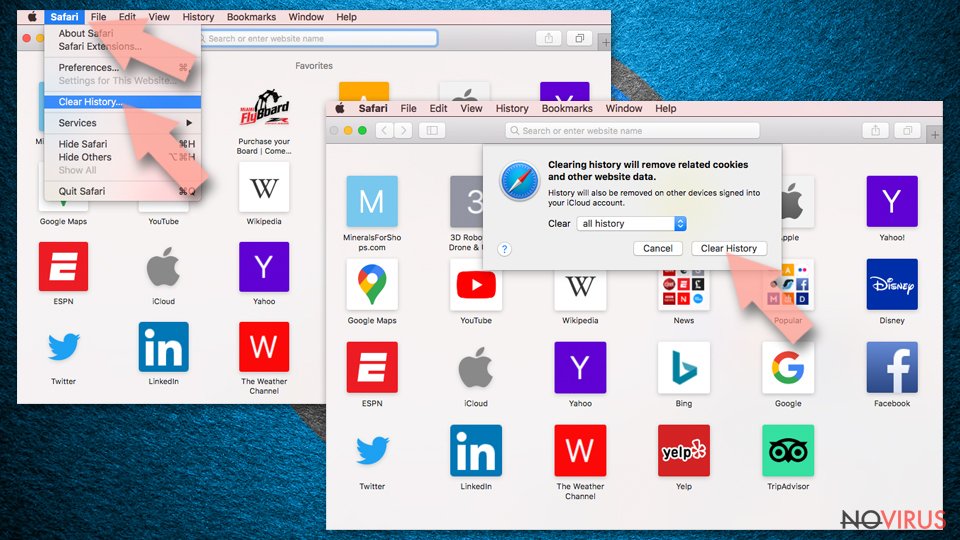
- From the drop-down menu under Clear, find and pick all history.
- Confirm with Clear History.
Reset Safari fully:
- Click Safari and then Preferences…
- Choose the Advanced tab.
- Tick the Show Develop menu in the menu bar.
- From the menu bar, click Develop.
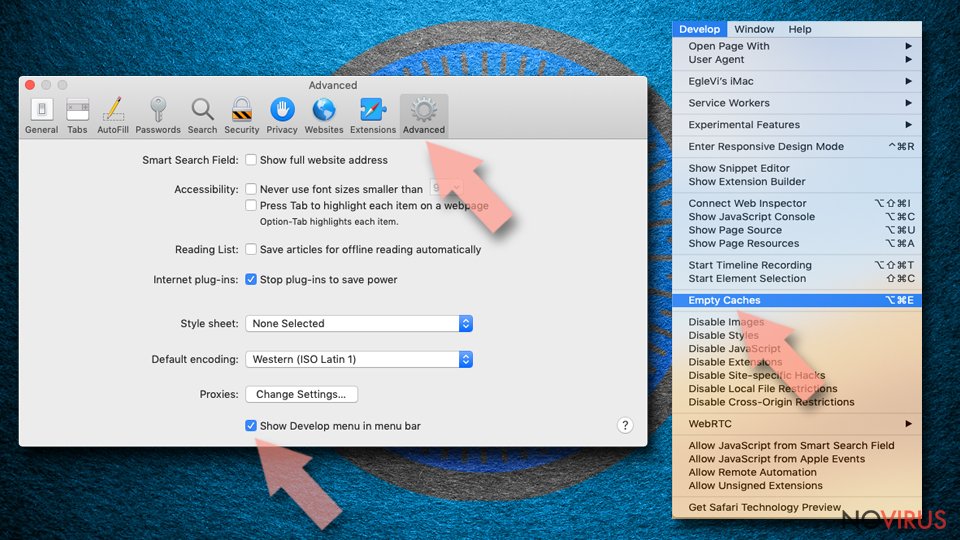
- Then select Empty Caches.
Even if you have completed all the steps above, we still strongly recommend you to scan your computer system with a powerful anti-malware software. It is advisable to do that because an automatic malware removal tool can detect and delete all remains of Nginx, for instance, its registry keys. The anti-malware program can help you to easily detect and eliminate possibly dangerous software and malicious viruses in an easy way. You can use any of our top-rated malware removal programs: FortectIntego, SpyHunter 5Combo Cleaner or Malwarebytes.
How to prevent from getting browser hijacker
Prevent the government from spying on you
As there is a growing debate in government about collecting users' data and spying on citizens, you should take a closer look at this issue and find out what shady ways of gathering information can be used to collect information about you. You need to browse anonymously if you want to avoid any government-initiated spying and tracking of information.
You can enjoy secure internet browsing and minimize the risk of intrusion into your system if you use Private Internet Access VPN program. This VPN application creates a virtual private network and provides access to the required data without any content restrictions.
Control government and other third party access to your data and ensure safe web browsing. Even if you do not engage in illegal activities and trust your ISP, we recommend being careful about your security. You should take extra precautions and start using a VPN program.
Recover files damaged by a dangerous malware attack
Despite the fact that there are various circumstances that can cause data to be lost on a system, including accidental deletion, the most common reason people lose photos, documents, videos, and other important data is the infection of malware.
Some malicious programs can delete files and prevent the software from running smoothly. However, there is a greater threat from the dangerous viruses that can encrypt documents, system files, and images. Ransomware-type viruses focus on encrypting data and restricting users’ access to files, so you can permanently lose personal data when you download such a virus to your computer.
The ability to unlock encrypted files is very limited, but some programs have a data recovery feature. In some cases, the Data Recovery Pro program can help recover at least some of the data that has been locked by a virus or other cyber infection.
